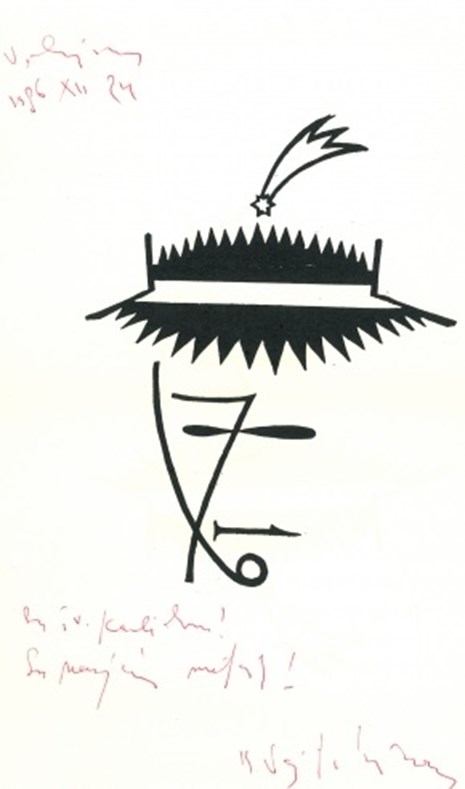Loose ends

Loose Ends
Artistic Communication by Mail
Loose Ends is an exhibition about artistic communication by mail,
about the sender and the receiver, or his/her absence, about the
thought that you start and not always finish, about speculative and
playful resistance against systems, rudiments of social networks in
the Soviet times and finally, about colliding comets. A comet is a
motif frequently appearing in artists' postcards. In the context of
the exhibition it becomes a rich metaphor: crossing systemic
limits, a sudden collision, a brief but spectacular flash,
sometimes ephemeral and sometimes causing hardly reparable long
term consequences.
The works and artefacts featured in the exhibition present a large
variety of purposes that artists used mail for. Mail is found to be
important as both a means of communication and as way of creating
artistic content. Being used locally for very personal purposes, as
well as with the intention for contact with international movements
- especially in the case of other means of communication being
unavailable. Mail was used to transport traditional artworks and to
inspire experimental work. Starting with a brief retrospective
journey to the interwar period, the exhibition showcases a sudden
burst of popularity of artistic correspondence in the early 1960s,
continuing up to contemporary art projects that are in some way
related to mail.
Looking at the abundance of New Year's greeting cards and seeing
how much time it took to produce these small but intricate prints,
photographs, collages or drawings, we can understand the importance
and scale of this communication network. New Year's postcards, as
an unofficial communication channel, thus took on even greater
importance as a means of self-representation: a proof of the
artist's abilities and resourcefulness.
The exhibition also reflects on the relations of Lithuanian
artists with collectors of various countries, organisers of
international exhibitions and Lithuanians in exile. In the 1970s,
Lithuanian artists got involved in the Fluxus movement. Later mail
art branched out into various movements and embraced various
experimental practices.
An important role in this exhibition is architectural, as
conceived by the artist Robertas Narkus, which landed in the hall
of the National Gallery of Art like a comet and gave an impulse to
rethink the relations between artistic experiments in the second
half of the 20th century and contemporary art, their meanings and
inspirations.
Artists: Valentinas Ajauskas, Alfonsas
Andriuškevičius, Valentinas Antanavičius, Jüri Arrak, Konstantinas
Bogdanas, Juozas Budraitis, Saulius Chlebinskas, Coolturistės,
Antanas Cukermanas, Kostas Dereškevičius, Gražina Didelytė,
Fluxus, Mindaugas Gapševičius, Laura Garbštienė, Rimtautas
Vincentas Gibavičius, Kęstutis Grigaliūnas, Antanas Gudaitis,
Kristina Inčiūraitė, Linas Jablonskis, Vaidas Jauniškis, Gediminas
Karalius, Romualdas Karpavičius, Arvydas Každailis, Rimvydas
Kepežinskas, Vincas Kisarauskas, Saulė Kisarauskienė, Antanas
Kmieliauskas, Tõnu Kõiv, Algimantas Kuras, Stanislovas Kuzma,
Rudolfas Levulis, Vitas Luckus, Aurelija Maknytė, Antanas
Martinaitis, Žibuntas Mikšys, Antanas Mončys, Vytautas Narbutas,
Gytis Norvilas, Eikantas Pakalka, Saulius Paukštys, Algirdas
Petrulis, Petras Repšys, Klaus Rödel, Edmundas Saladžius,
Ferdinandas Saladžius, Mindaugas Skudutis, Gytis Skudžinskas,
Birutė Stančikaitė, Algirdas Steponavičius ir Birutė Žilytė,
Vitalij Strigunkov, Arvydas Šaltenis, Lidija Šimkutė, Ričardas
Šileika, Gintautas Trimakas, Raimondas Urbonas, Vytautas Valius,
Antanina Ramunė and Norbertas Vėlius, Ričardas Povilas Vaitiekūnas,
Vytautas and Sigutė Valius, Mikalojus Povilas Vilutis, Viktoras
Vizgirda, Izaokas Zibucas and others.
Curators: Danutė Gambickaitė, Aistė
Kisarauskaitė, Ieva Pleikienė
Architect: Robertas Narkus
Partners: The Jonas Mekas Visual Arts, A. and P.
Galaunė House, Lithuanian Archives of Literature and Art, Mo Museum
(Vilnius)
This project was partly financed by the
Lithuanian Council for Culture
Sponsor: Exterus
Organizer Lithuanian Art Museum / National
Gallery of Art, Vilnius


